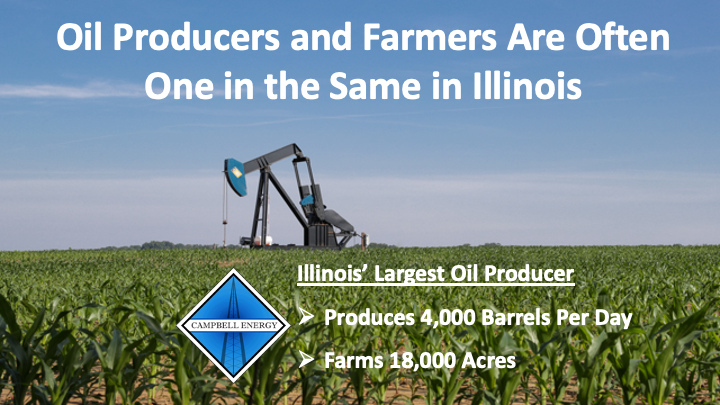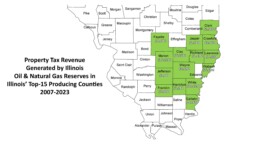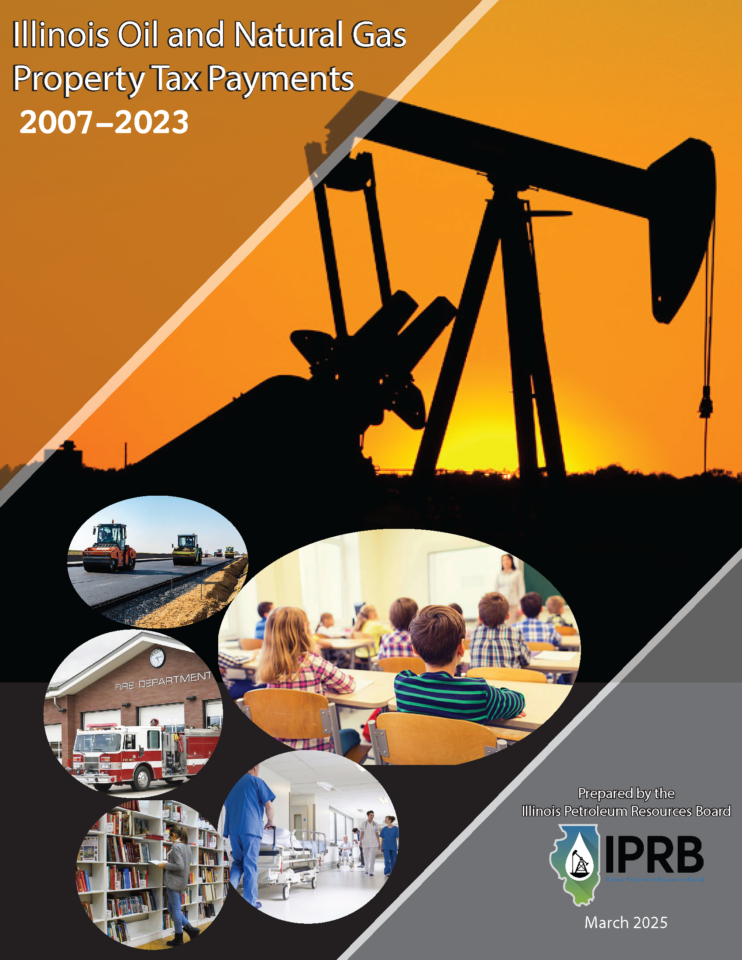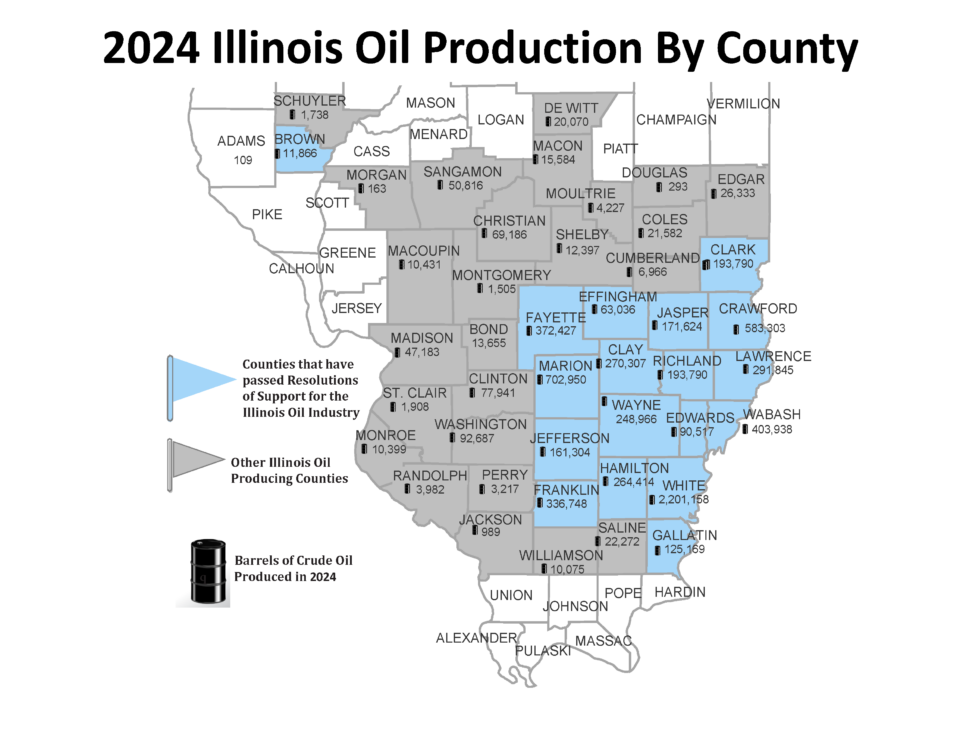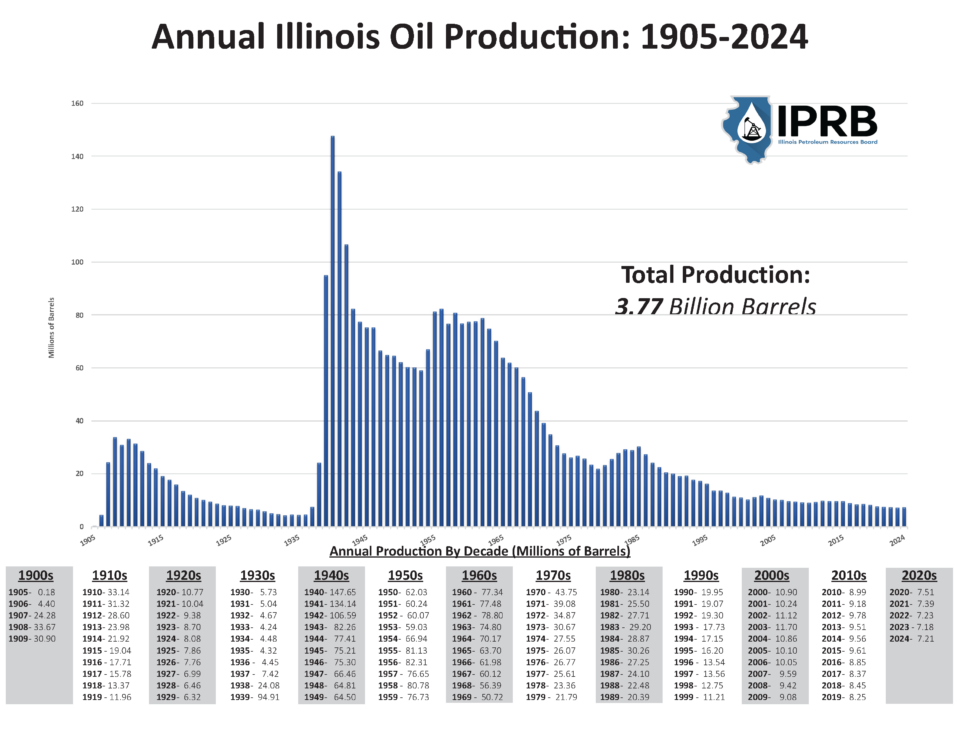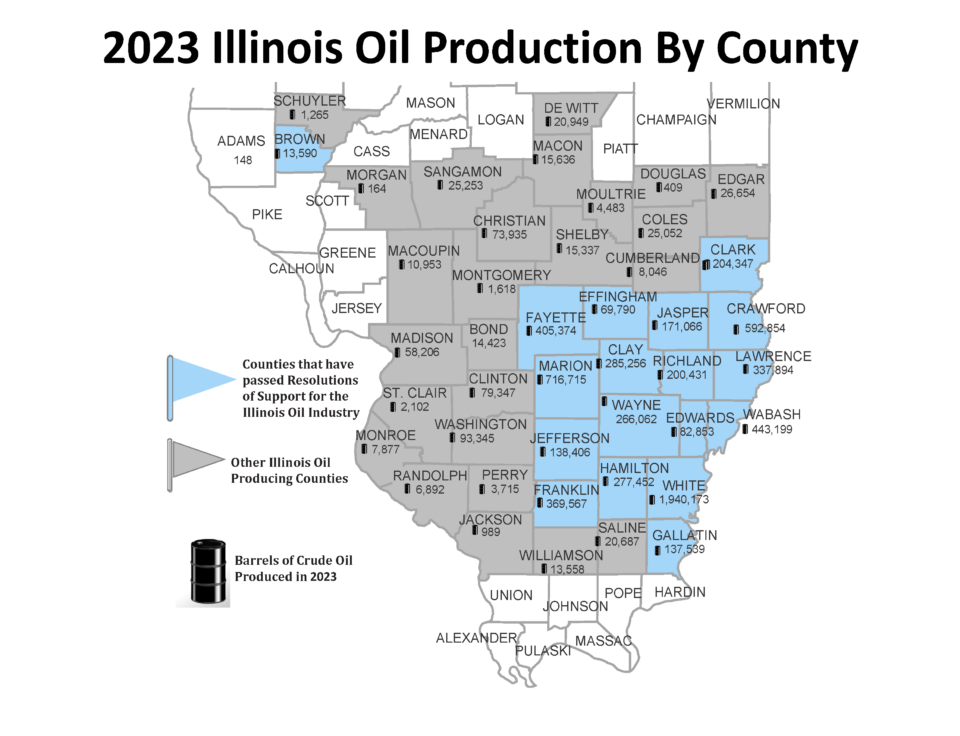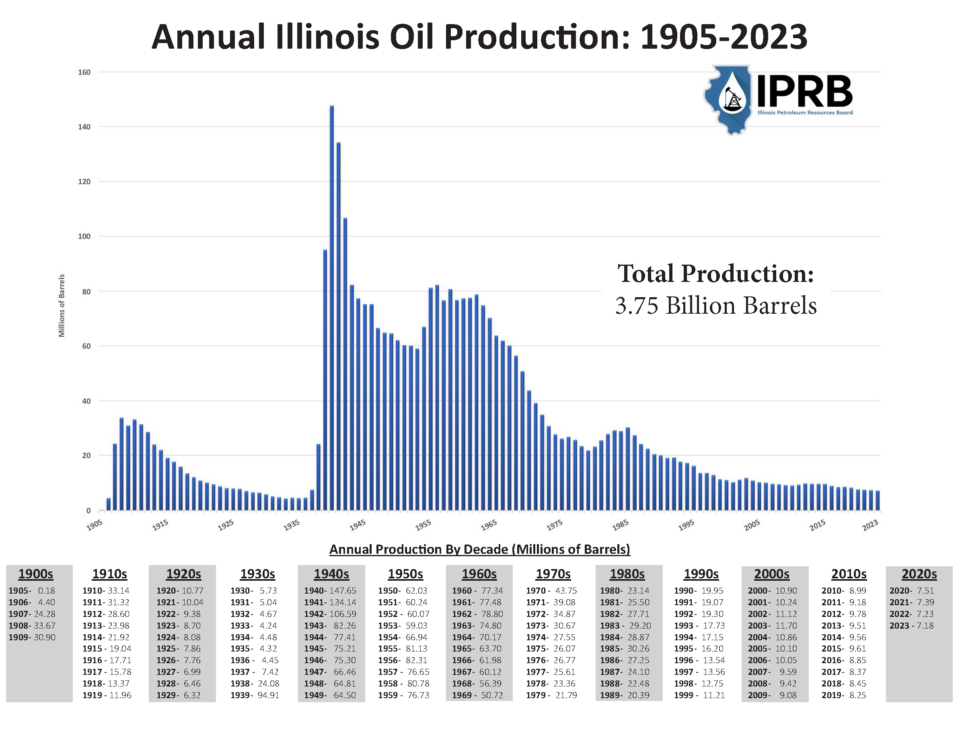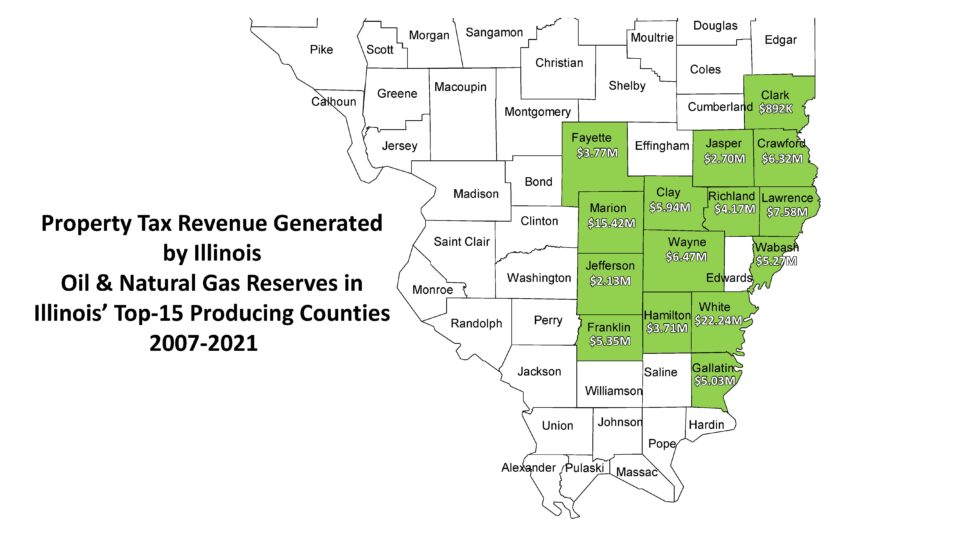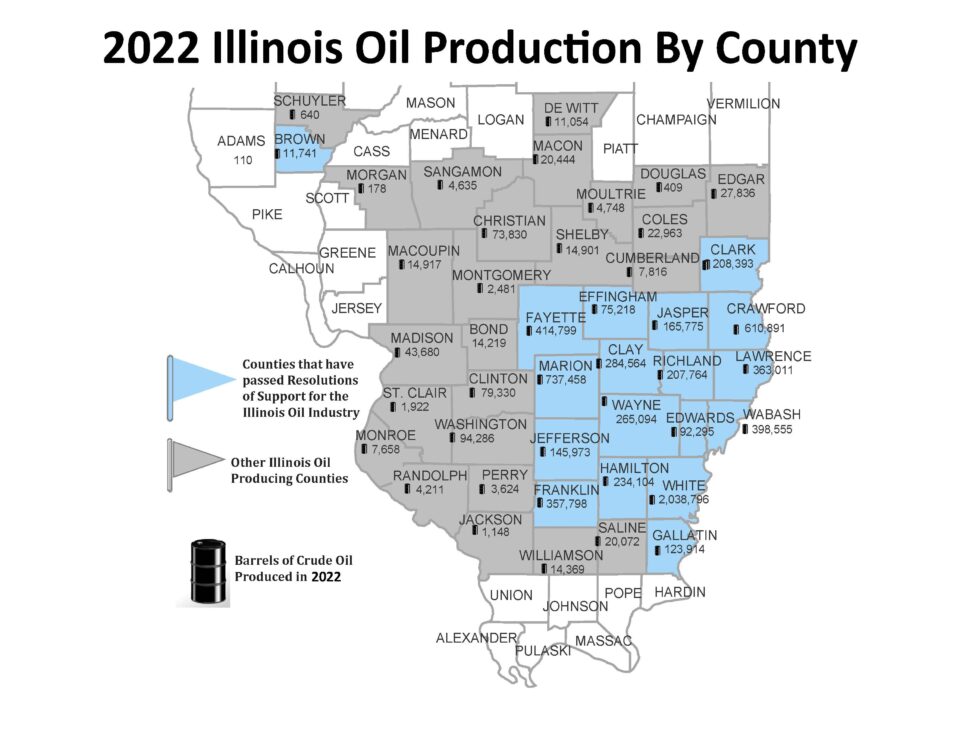Illinois Oil: A Little-Known Land of Lincoln Staple
Nearly four billion barrels of oil have been produced in Illinois since commercial production began way back in 1905.
Pump jacks are as common - albeit spread out - in southeastern Illinois as skyscrapers are to Chicago. Still, millions of Illinoisans have no idea there are oil wells in the state. And many of those who are aware of Illinois’ storied oil production history may not know key facts about the present-day industry that distinguish it from the “Big Oil” stereotype that is so prevalent today.
Over the decades, Illinois has risen to the status of being the country’s third-largest oil producing state on two occasions (1907-1912 and 1940). The state’s production even outpaced Iran and Iraq’s combined production in 1940, and Illinois oil production literally helped fuel the Allied Forces defeat of the Axis Powers in World War II.
For decades, publicly traded giants like ExxonMobil and Texaco dominated production in the Land of Lincoln. Fast forward to today, and those “Big Oil” companies are all gone, but Illinois oil production remains vital to hundreds of downstate families and dozens of Southern Illinois communities. More than 1,000 small, independent companies continue to produce between 7-8 million barrels of oil annually in rural areas far south of Chicago. A vast majority of these companies are family-owned and based in the same small communities where they produce.
Similar to Illinois farms – 96 percent of which are family-owned – typical Illinois oil producers are mom-and-pop companies. In fact, many Illinois oil producers are farmers as well. For example, family-owned Campbell Energy in Carmi is not only Illinois’ largest oil producer, it has also been one of the state's more prominent family-owned farms for decades.
The average daily production of the Illinois oil production companies today ranges between 12 and 13 barrels per day, dwarfed by the state controlled Saudi Aramcos and Rosnefts of the world. But although Illinois petroleum producers are anything but “Big Oil,” they have a huge economic impact in the state.
Illinois oil production generated half a billion dollars in gross receipts last year, including $70 million in royalty income for mineral owners. The industry directly employs roughly 4,000 directly and supports another 10,000 jobs indirectly. Illinois oil producers also pay an average $700 million annually in state, federal and local property taxes, the latter of which help fund public schools near production. When the state’s four refineries and the Patoka tank farm – the second-largest bulk storage facility in the United States – are added in the mix, Illinois remains a low-key petroleum industry powerhouse, employing more than 20,000 residents with well-paying jobs while generating more than $23 billion in gross regional product.
In a world demanding more and more oil even as those who produce it are demonized or taken for granted, Illinois oil producers remain remarkably resilient and off the radar – even in their own state.
But as significant as Illinois’ oil past and present are, the future remains brighter than most realize.
It is estimated that nearly four billion barrels of oil remain in the Illinois Basin, oil that can be accessed with deeper drilling or new technologies like horizontal drilling and hydraulic fracturing of the New Albany Shale and enhanced oil recovery using liquified carbon dioxide sequestration.
Oil remains essential, not only to Illinois, which consumes more than a half million barrels per day, but the world as a whole. We will continue to rely on petroleum for decades, not only for transportation fuels that move the products that make our modern lives possible around the world, but more than 6,000 petroleum-based products.
With 90 percent of the state’s oil production occurring where just two percent of the Land of Lincoln’s residents reside, Illinois oil producers are largely out of sight and out of mind. But they remain an integral component of the Land of Lincoln’s past, present and future.
Illinois Oil Reserve Property Tax Revenue Has Averaged $7.1 Million Per Year Since 2007
Many Illinoisans may not be aware that the state’s active oil production leases are assessed and taxed as real estate, similar to property taxes paid on a residential home. All of the revenue collected from this tax – known as an ad valorem tax – stays at the local level and goes directly to support the areas where oil is produced, including counties, villages, townships, cities, and – most importantly – local schools.
An IPRB review of the latest Illinois Department of Revenue (IDOR) data shows that Illinois oil reserves generated $121.1 million in ad valorem tax revenue from 2007 to 2023, an average of more than $7.12 million per year. IPRB details this revenue in an updated annual report that can be downloaded here and by clicking the image below.
IDOR data also show that nearly 60 percent of this $121.1 million in revenue went to fund K-12 public schools near production. For our 2025 ad valorem report, IPRB downloaded the exact percentage of ad valorem revenue that went toward K-12 public schools near production for each year of the report (2007-2023) in each producing county, finding approximately $72.6 million of the total $121.15M in ad valorem tax revenue collected from 2007-2023 went to fund K-12 public schools in producing counties. This is upwardly revised from IPRB’s previous reports (2019, 2020, 2021 and 2022), which had conservatively estimated 50 percent of the total oil reserve ad valorem revenue collected went to K-12 public schools near production.
Ad valorem tax revenue from Illinois oil production has a particularly significant impact in major producing counties. IDOR data show that ad valorem tax revenue in Illinois’ top-15 oil producing counties totaled $108.5 million from 2007-2023, an average of more than $6.38 million per year. See the graphic below for revenue totals in each of the state’s top-15 oil producing counties.
IPRB estimates that approximately $65.1 million of that revenue went to K-12 public schools in those top-15 producing counties.
It is important to note that many of these counties have relatively small populations and are relatively poor compared to many other state counties and the state as a whole. In fact, all but one of Illinois’ top oil producing counties (Crawford) have poverty rates that are higher than the national average – adding even more significance to the ad valorem tax revenue generated by oil and natural gas reserves in these counties. Just two percent of Illinois’ overall population resides in these top-15 producing counties, which are responsible for 90 percent of Illinois oil production.
County-level reports for each of Illinois’ top-15 producing counties can be downloaded at the links below. An example of the county-level reports can also be viewed below.
- White County
- Marion County
- Crawford County
- Wabash County
- Fayette County
- Franklin County
- Lawrence County
- Clay County
- Wayne County
- Hamilton County
- Richland County
- Jasper County
- Clark County
- Jefferson County
- Gallatin County
It is important to understand that these taxes are based on estimates of oil and gas reserves remaining in the ground, not oil and natural gas produced. The annual ad valorem tax bill that operators and royalty owners receive is also based on data that is over two years old. For example, ad valorem taxes paid in 2017 were based on a 2016 assessment of active leases that is calculated using 2015 production totals. There are also reductions for leases based upon lease age, secondary recovery methods used and production.
As complicated as the ad valorem tax calculation system may be, it is clear that these taxes are generating significant revenues in the communities where they operate, specifically for local schools.
Illinois Oil Production Increased Slightly in 2024
Illinois year-over-year crude oil production increased slightly in 2024, totaling 7,212,196 barrels, according to data collected from first-purchaser reports by the Illinois Petroleum Resources Board. Click here to download IPRB’s annual Illinois oil production report.
Production was up .39 percent from 2023 levels, the first year-over-year oil production increase in the state since 2018.
White County enjoyed the largest increase in production of the state’s 45 oil-producing counties, totaling 2,201,158 barrels of production, a whopping 261,000-barrel increase from its 2023 totals. White County saw its highest production since 2020 and accounted for more than 30 percent of the state’s overall production.
Sangamon County saw the biggest year-over-year production increase in percentage terms, more than doubling its 2023 production with 50,186 barrels of production.
Jefferson (+22,900 barrels), Edwards (+7,700 barrels), Monroe (+2,500 barrels), Saline (+600 barrels) and Schuyler (+500 barrels) also saw year-over-year production increases from 2023 totals.
The state’s top-15 producing counties – White, Marion, Crawford, Wabash, Fayette, Franklin, Lawrence, Clay, Hamilton, Wayne, Richland, Clark, Jasper, Jefferson and Gallatin – collectively produced 90 percent of the state’s oil in 2023. All 15 of those counties – as well as Edwards, Brown and Effingham counties – have passed Resolutions of Support for the Illinois oil production industry.
Illinois has totaled more than 3.77 billion barrels of oil production since commercial production began in 1905.
February 7, 2025
Illinois Crude Oil Production Totaled 7.18M Barrels in 2023
Illinois crude oil production totaled 7,184,282 barrels in 2023, according to data compiled by the Illinois Petroleum Resources Board (IPRB) that is based on first-purchaser reports. Click here to download IPRB’s annual Illinois oil production report.
The state’s 2023 production 0.59 percent below 2022 production levels (7,227,172 barrels).
Several counties did see significant increases in production compared to 2022 levels, led by Wabash County’s 44,644-barrel increase in production to 443,199 barrels in 2023. That made Wabash County Illinois’ fourth-largest oil producing county despite being one of the smallest counties geographically in the state.
Hamilton County saw a similar year-over-year production increase in 2023, with production jumping 43,349 barrels to 277,452 barrels – making it Illinois’ No. 9 producing county.
Franklin County saw a third straight year of increased production, as its production jumped three percent compared to 2022 levels to a total of 369,567 barrels last year. Franklin County enjoyed a 15 percent production increase from 2021 levels in 2022 and has increased production nearly 42 percent from 2020 levels over the past three years, catapulting it to become the state’s sixth most prolific producing county.
Minor producing counties Sangamon (+20,618 barrels), Madison (+14,527), Dewitt (+9,865), Randolph (+2,6981), Coles (+2,090) and Brown (+1,849) all saw significantly increased production last year, while traditional top-15 producing counties Gallatin (+13,625), Jasper (+5,290), Wayne (+968) and Clay (+692) enjoyed upticks in production compared to 2022.
White County once again led the state in production by a wide margin (1,940,173 barrels), although its production decreased by 98,623 barrels compared to 2022.
The state’s top-15 producing counties – White, Marion, Crawford, Fayette, Lawrence, Wabash, Franklin, Clay, Wayne, Clark, Richland, Hamilton, Jasper, Jefferson and Gallatin – collectively produced 90 percent of the state’s oil in 2023. All 15 of those counties – as well as Edwards, Brown and Effingham counties – have passed Resolutions of Support for the Illinois oil production industry.
Illinois has totaled more than 3.75 billion barrels of oil production since commercial production began in 1905.
Demise of Gasoline-Powered Vehicles Has Been Greatly Exaggerated
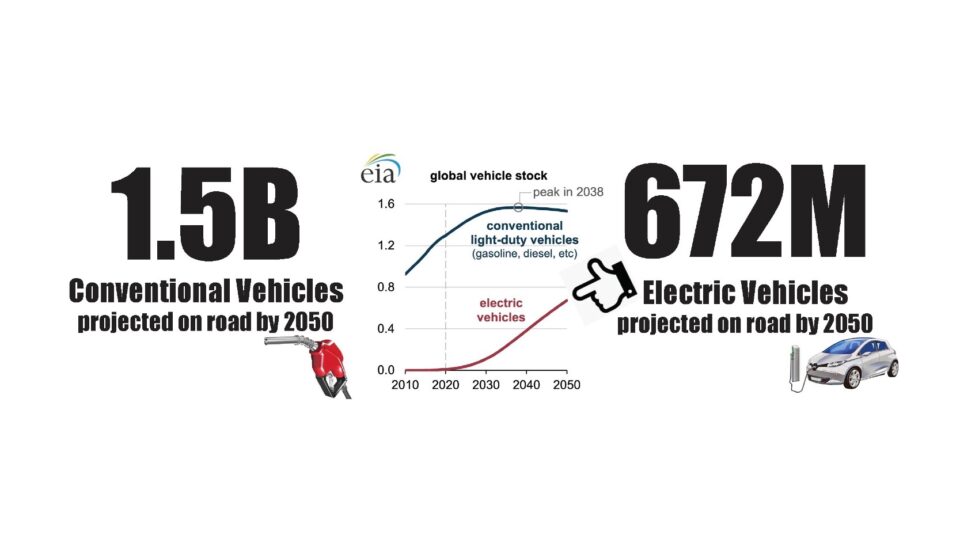
The chasm between electric vehicle hype and reality was never more profound than during last year’s Super Bowl.
You may recall seeing one electric vehicle commercial after another during the big game. The ads were slick. They were hip. And based on their frequency, one might guess the EV revolution just around the corner. Instead, headline after headline throughout 2023 confirmed an undeniable truth: The demise of internal combustion engine (ICE) vehicles has been greatly exaggerated.
Contrary to the prevailing narrative, new gasoline vehicle registrations continued to rise both in the United States and throughout the world last year. The world also used more gasoline than ever in 2023. And although the number of electric vehicles (EVs) in the United States has increased to about three million, that figure is dwarfed by the 265 million-plus conventional vehicles on American roads.
There are many reasons automakers are cutting back on plans to dramatically expand EV manufacturing and nearly 4,000 auto dealers penned a letter urging President Biden to “tap the brakes” on proposed emissions regulations that would mandate two-thirds of new vehicle sales be electric by 2032.
A December Consumer Reports analysis found EVs have nearly 80 percent more issues and are less reliable overall than their ICE counterparts. EVs are also generally more expensive, more costly to insure and tougher to repair than conventional vehicles.
No wonder a University of Chicago poll released last year found nearly half of Americans say they are unlikely to buy an EV any time soon. Just 19 percent of the respondents said it’s “very” or “extremely” likely they would buy an EV when they next go vehicle shopping. And another survey found 45 percent of Americans would be upset if gasoline-powered cars were phased out.
With more than a billion conventional passenger vehicles on the road worldwide and countless headwinds for widespread EV adoption – most notably lack of charging infrastructure and heavy reliance on China for battery materials and manufacturing – it’s time EV advocates stop pushing unpopular and impractical mandate proposals and accept reality: EVs and conventional vehicles can, and will, coexist for decades to come. And they can do so while both becoming more protective of the environment.
Contrary to popular belief, EVs are not “green” emissions-free climate panaceas – their emissions just happen to come from somewhere other than a tailpipe. The Wall Street Journal reported in 2021 that carbon dioxide emissions from a Tesla Model 3 are actually higher than a Toyota RAV4 for the first 20,000 miles the vehicles are driven. And as the New York Times recently reported, “Electric cars and renewable energy may not be as green as they appear. Production of raw materials like lithium, cobalt and nickel that are essential to these technologies are often ruinous to land, water, wildlife and people.”
Conventional cars obviously release carbon dioxide and other tailpipe emissions. But ICE vehicles have become far less polluting and more fuel efficient over the past 50-plus years.
U.S. Environmental Protection Agency data show that although the number of passenger vehicles on American roads has more than doubled and total miles driven has tripled since 1970, overall U.S. aggregate emissions of the six most common pollutants have declined 78 percent and CO2 emissions have declined nine percent during that time-span. The EPA also reports that new passenger vehicles are 98 to 99 percent cleaner for most tailpipe pollutants than they were in the 1960s.
To be clear, this emissions progress needs to continue trending in the right direction, and emission reduction innovation should be prioritized. But the notion that banning ICE vehicles and mandating EVs will eliminate all emissions is misleading.
These facts illustrate why the Alliance for Automotive Innovation – which represents companies responsible for more than 96 percent new vehicles sold in the United States – has commented that proposed tailpipe regulations that would effectively mandate EVs are “neither reasonable nor achievable in the time frame covered in this proposal.”
Average Americans count on their conventional passenger vehicles for reliable, affordable and essential transportation. So despite all the EV hype you’ll likely see again this Super Bowl Sunday, don’t be surprised if conventional vehicles still dominate American roads for years to come.
More Than 150 Attend 2nd Annual Illinois Basin Celebration

More than 150 Illinois Basin oil exploration and production industry professionals attended the second annual Illinois Basin Celebration at the 404 Seed Station in Carmi on Friday, Oct. 13.
The event was organized by the Illinois Petroleum Resources Board (IPRB) to recognize the efforts of the more than 4,000 Illinois Basin oil exploration and production industry professionals and featured a complimentary lunch and presentation by guest speaker Warren Martin of Kansas Strong.
Martin’s presentation focused on essential need for petroleum now and in the future, and the importance of industry advocacy by those who work in the oil and gas industry.

Kansas Strong executive director Warren Martin makes his presentation at the 2nd Annual Illinois Basin Celebration.
Complimentary “Illinois Basin Proud” hats, T-shirts, flags and bumper stickers were also handed out to attendees.
The event also included an IPRB Petro Pros presentation to a group Carmi-White County agriculture students by industry volunteers Mike Payne of Shawnee Oil Company, Ross Basnett of Campbell Energy, Travis Thompson of Travis Thompson Oil Corp. and IPRB executive director Seth Whitehead. Campbell Energy and Travis Thompson Oil Corp. also displayed various oilfield equipment for the Petro Pros volunteers to show the students.
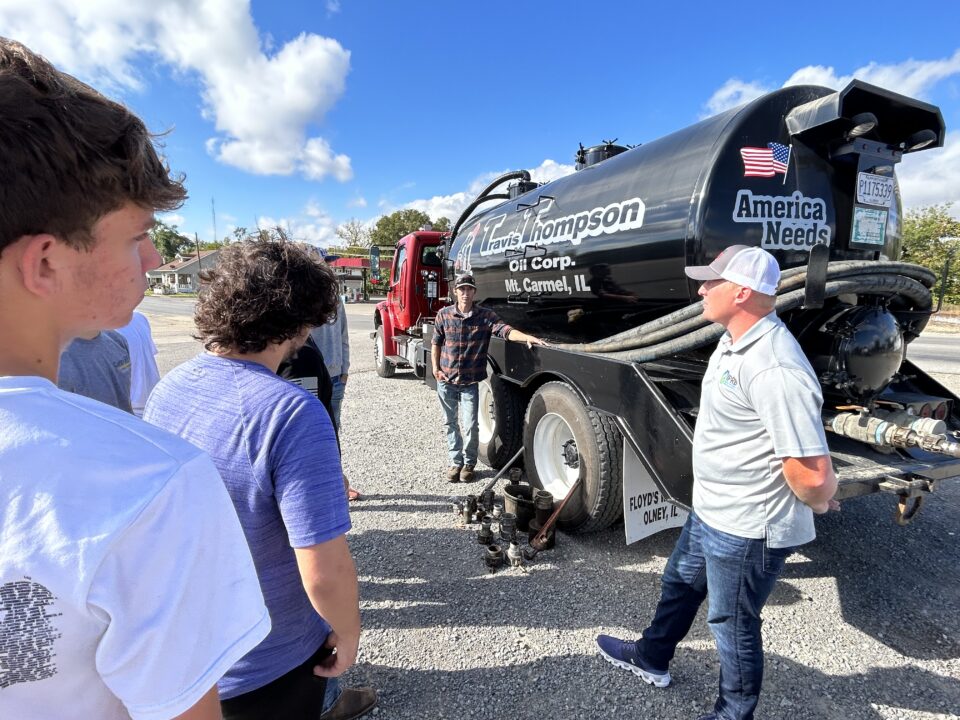
Travis Thompson and Eli Fears of Travis Thompson Oil Corp. conduct a tank truck demonstration.
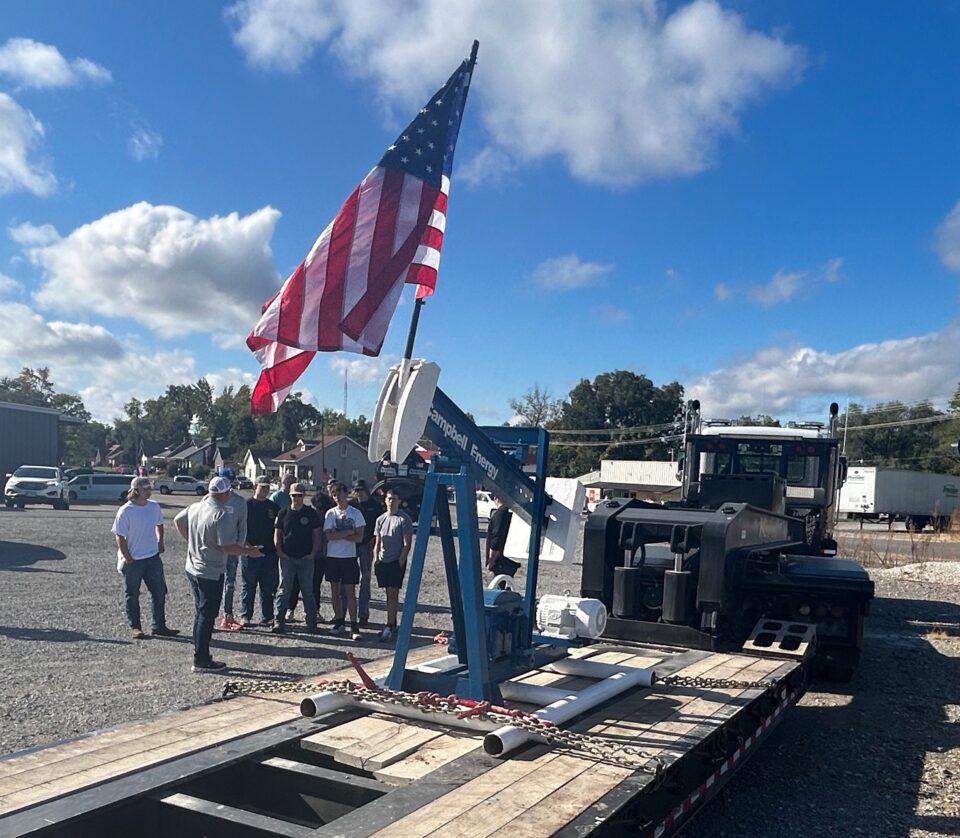
Travis Thompson of Travis Thompson Oil Corp. explains how a pumping unit works.

Carmi-White County agriculture students look on as Campbell Energy employees rig up a spudder.
The Petro Pros presenters also shared information with the Carmi-White County High School attendees about career opportunities in the Illinois Basin. There is currently high demand for almost all of the 75-plus oil exploration and production industry careers, with particularly high demand for truck drivers, electricians, plumbers, welders, roustabouts and various rig and well servicing crew members.
Most of the 150-plus attendees were able to stick around after lunch to pose for the above group photo.
Between 10-12 million barrels of oil is produced annually in the Illinois Basin, which includes southern Illinois, southwestern Indiana and western Kentucky.
Illinois oil production alone makes a $3 billion annual economic impact, generating $770 million in yearly personal and business income and $700 million in state and federal tax revenue. More than 30,000 Illinoisans receive royalty income from Illinois oil production, and active Illinois oil leases have generated an average of $7.24 million in local property tax revenue per year since 2007. More than half of that revenue has gone to fund schools near production.
The third annual Illinois Basin Celebration will be held next year in Carmi at a yet-to-be-determined date.


Why Americans Aren’t Likely to Embrace Electric Vehicle Mandates
You’d never guess it based on the nonstop barrage of slick TV ads and media hype, but Americans aren’t big fans of electric vehicles. In fact, a new Gallup poll shows that just four percent currently own an EV and four in 10 have no interest in buying one.
There are many legitimate reasons why this is the case. But U.S. consumers may have far less choice in the matter in the not-so-distant future.
Proposed U.S. Environmental Protection Agency rules would effectively mandate by 2032 that two out of every three new passenger vehicles sold in the United States are electric. And a handful of states will ban sales of new conventional vehicles starting in 2035.
The writing is on the wall: Choose to buy an EV now or be forced to do so later. To be clear, EVs have their place and everyone should be free to purchase one if they want. But there are plenty of red flags flapping in the strong winds blowing in an EV-only direction.
First and foremost, most Americans simply can’t afford an EV. The average cost of an all-electric passenger vehicle was $66,000 in 2022. Even Democrats are acknowledging that price tag is too much for most of their constituents. Rep. Debbie Dingell recently said, “Everybody cares about global warming, but I’m hearing from too many people in this country – I mean, strong Democrats – that they can’t afford an electric vehicle.”
And because EVs are dependent on foreign sources for massive quantities of battery minerals, their costs aren’t likely to decrease any time soon – especially if demand suddenly spikes due to mandates. It is because EV components are largely sourced from countries that have poor relationships with the United States and questionable labor practices that many EV models aren’t eligible for the generous $7,500 tax credit included in the Inflation Reduction Act.
Nearly 90 percent of EV battery minerals are refined by China, and half of EV battery minerals are either mined by or in China. More than 70 percent of the world’s cobalt is extracted in The Democratic Republic of the Congo – much of it by Chinese companies that use child labor. EVs require 2 ½ times the copper of conventional vehicles, which is good news for politically volatile Peru and Chile, which mine 40 percent of world’s most prominent “electrification metal.”
In other words, going “green” does not make us energy independent. It instead makes these countries the OPEC of alternative energy. Consumers are also rightly concerned about a lack of charging stations, further burdens on an already overextended electrical grid, poor battery performance in cold weather and limited battery lifespans in general.
But the environmental benefits of EVs far outweigh these issues, right?
Though EVs are responsible for less carbon dioxide emissions over their lifespans than their conventional counterparts, they are by no means “emission free” or a “green” climate change panacea.
It can actually take several years for an electric vehicles’ carbon footprint to drop below that of a conventional vehicle. The Wall Street Journal reported last year that emissions attributable to the Tesla Model 3 are higher than the gasoline-burning Toyota RAV4 for the first 20,000 miles that the vehicles are driven. Assuming both vehicles are driven 200,000 miles, the lifecycle carbon footprint of the RAV4 winds up being 78 tons of CO2 emissions, compared to 36 tons for the Tesla Model 3.
Even the New York Times reports, “Electric cars and renewable energy may not be as green as they appear. Production of raw materials like lithium, cobalt and nickel that are essential to these technologies are often ruinous to land, water, wildlife and people.”
These are just a few of the reasons four out of 10 Americans have no plans to buy an EV now or in the future. The hesitation is simple: affordable, reliable transportation is a necessity for most Americans. Fortunately, conventional cars are becoming increasingly efficient while remaining far more affordable than EVs.
We will need all-of-the-above options for our transportation and energy needs for many years to come. EV mandates are tone-deaf to this reality.
Updated Report: Illinois Oil Reserves Generated $108.6M in Local Property Tax Revenue From 2007-2021
Many Illinoisans may not be aware that the state’s active oil production leases are assessed and taxed as real estate, similar to property taxes paid on a residential home. All of the revenue collected from this tax – known as an ad valorem tax – stays at the local level and goes directly to support the areas where oil is produced, including counties, villages, townships, cities, and – most importantly – local schools.
An IPRB review of the latest Illinois Department of Revenue (IDOR) data shows that Illinois oil reserves generated $108.6 million in ad valorem tax revenue from 2007 to 2021, an average of more than $7.24 million per year. IPRB details this revenue in an updated annual report that can be downloaded here and by clicking the image below.
IDOR data also show that nearly 60 percent of this $108.6 million in revenue went to fund K-12 public schools near production. For this year’s report, IPRB downloaded the exact percentage of ad valorem revenue that went toward K-12 public schools near production for each year of the report (2007-2021) in each producing county, finding approximately $64.8 million of the total $108.6M in ad valorem tax revenue collected from 2007-2021 went to fund K-12 public schools in producing counties. This is upwardly revised from IPRB’s previous reports (2019, 2020, 2021 and 2022), which had conservatively estimated 50 percent of the total oil reserve ad valorem revenue collected went to K-12 public schools near production.
Ad valorem tax revenue from Illinois oil production has a particularly significant impact in major producing counties. IDOR data show that ad valorem tax revenue in Illinois’ top-15 oil producing counties totaled $97.05 million from 2007-2021, an average of more than $6.47 million per year. See the graphic below for revenue totals in each of the state’s top-15 oil producing counties.
IPRB estimates that approximately $57.88 million of that revenue went to K-12 public schools in those top-15 producing counties.
It is important to note that many of these counties have relatively small populations and are relatively poor compared to many other state counties and the state as a whole. In fact, all but one of Illinois’ top oil producing counties (Crawford) have poverty rates that are higher than the national average – adding even more significance to the ad valorem tax revenue generated by oil and natural gas reserves in these counties. Just two percent of Illinois’ overall population resides in these top-15 producing counties, which are responsible for 90 percent of Illinois oil production.
County-level reports for each of Illinois’ top-15 producing counties can be downloaded at the links below. An example of the county-level reports can also be viewed below.
- White County
- Marion County
- Crawford County
- Lawrence County
- Fayette County
- Wabash County
- Wayne County
- Franklin County
- Clay County
- Richland County
- Hamilton County
- Clark County
- Jasper County
- Gallatin County
- Jefferson County
It is important to understand that these taxes are based on estimates of oil and gas reserves remaining in the ground, not oil and natural gas produced. The annual ad valorem tax bill that operators and royalty owners receive is also based on data that is over two years old. For example, ad valorem taxes paid in 2017 were based on a 2016 assessment of active leases that is calculated using 2015 production totals. There are also reductions for leases based upon lease age, secondary recovery methods used and production.
As complicated as the ad valorem tax calculation system may be, it is clear that these taxes are generating significant revenues in the communities where they operate, specifically for local schools.
Illinois Oil Production Totaled 7.22M Barrels in 2022
Illinois crude oil production totaled 7,227,842 barrels in 2022, according to data compiled by the Illinois Petroleum Resources Board (IPRB) that is based on first-purchaser reports. Click here to download IPRB’s annual Illinois oil production report.
The state’s 2022 production was 2.3 percent below 2021 production levels (7,397,119 barrels), as continued labor shortages and weather-related challenges trumped high oil prices and increased drilling activity, holding production down below 2021 levels.
Several counties did see significant increases in production compared to 2021 levels, however, led by Hamilton County’s 51,077-barrel increase in production to 234,104 barrels of production in 2022.
Franklin County saw a second straight year of sharply increased production, as its production jumped 15 percent compared to 2021 levels to a total of 357,798 barrels last year. Franklin County enjoyed a 19 percent production increase from 2020 levels in 2021 and has increased production 38 percent from 2020 levels over the past two years.
Wabash County increased production 12 percent in 2022 compared to 2021 levels with a total of 398,555 barrels. Christian, Richland, Dewitt, Sangamon, Clay, Crawford and Clinton counties all saw their production increase by at least 1,000 barrels in 2022 compared to 2021 levels.
White County once again led the state in production by a wide margin, topping two million barrels of production for the fourth straight year (2,038,796 barrels). However, that total was more than 127,303 barrels below 2021 production levels.
The state’s top-15 producing counties – White, Marion, Crawford, Fayette, Lawrence, Wabash, Franklin, Clay, Wayne, Clark, Richland, Hamilton, Jasper, Jefferson and Gallatin – collectively produced 90.2 percent of the state’s oil in 2022. All 15 of those counties – as well as Edwards, Brown and Effingham counties – have passed Resolutions of Support for the Illinois oil production industry.
Benefits of Fossil Fuels to Humanity Have Far Outweighed Negatives
The Natural Resources Defense Council claims fossil fuels have “exacted an enormous toll on humanity.” It is a belief shared and amplified by millions of “Keep It In the Ground” activists. But there are actually billions of examples why that opinion couldn’t be further from the truth. Eight billion, to be specific.
That latter figure happens to be the earth’s current population – eight times the amount of people that resided on the planet 200 years ago.
Prior to the wide-scale use of oil, natural gas and coal to make the high standard of living we enjoy today possible, eight out of 10 people lived in extreme poverty and most folks didn’t make it past their 30th birthday. As the Brookings Institute’s Samantha Gross recently wrote, “The pre-fossil era was not the utopia we envision.” Instead, it was rather miserable for a vast majority of the world’s occupants, most of which died far too young.
Fast forward a couple centuries, and the average person now lives more than 70 years and less than one in 10 people live in extreme poverty – the lowest level in human history. There has never been a better time to be alive. And it’s no coincidence fossil fuel use grew from almost nothing to 80-plus percent of the world’s energy supply over the past 200 years.
Contrary to the Natural Resources Defense Council’s claim that fossil fuels have “exacted an enormous toll on humanity,” the fossil fuel age has actually allowed humanity to flourish in unprecedented fashion. The examples why are almost too numerous to count.
Fossil fuels provide heat during the cold winter months, air conditioning during sweltering summer months and reliable electricity year-round. They have allowed access to healthcare via improved mobility, as well as medicines and petroleum-based healthcare products. They allow improved health in general by providing plentiful food, drinking water treatment and sewage management. These modern conveniences have improved the quality of life in the United States and other fortunate developed countries, leading directly to increased economic opportunity and longer lives, in general.
Even James Hansen, widely known as the father of global warming awareness, has said, “Let’s be clear: the frequent comparison of the fossil fuel and tobacco industries is nonsense. Fossil fuels are a valuable energy source that has done yeoman service for humankind.”
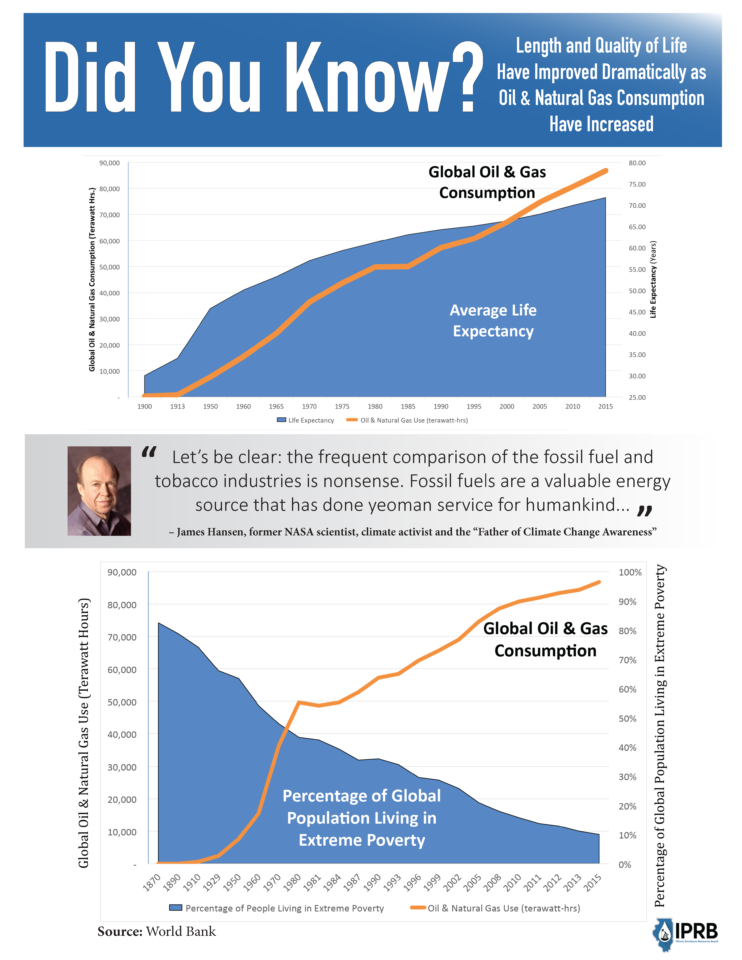
To be clear, fossil fuels, like all sources of energy, have environmental impacts. But it is dangerously misleading to focus exclusively on those impacts and completely ignore their massive benefits. And using this deeply flawed framing as the basis of campaigns to rapidly eliminate the source of 83 percent of the world’s energy and virtually all our modern products is even more dangerous considering the favored “alternatives” are completely inadequate to replace fossil fuels.
It can’t be emphasized enough that renewable energy – specifically wind and solar – can only generate electricity, and do so only when the sun is shining and the wind is blowing.
Wind and solar are not only unreliable for power generation, they provide no replacement for the thousands of uses for petroleum that are essential and largely taken for granted. More than 6,000 everyday products, including dozens of electronics such as smart phones and computers, are largely petroleum-based. Petrochemicals are even needed to manufacture wind turbines, solar panels and more than 70 percent of the typical electric car. As Vanclav Smil, Distinguished Professor Emeritus at the University of Manitoba, recently wrote in TIME magazine, each of the four pillars of modern civilization – ammonia fertilizer produced from natural gas, plastic, steel and cement – could not exist without fossil fuels.
Simply stated, if oil, natural gas and coal were rapidly eliminated as “Keep It In the Ground” groups such as the Natural Resources Defense Council advocate for, the voids created would be far worse than the issues fossil fuels create. That said, focus should center on pragmatically reducing emissions via technologies such as carbon capture and diversifying our energy supply will all forms of energy rather than irrationally eliminating fossil fuels before viable alternatives are available. Stubbornly insisting on the latter would actually take an “enormous toll” on the flourishment of humanity fossil fuels have made possible.



